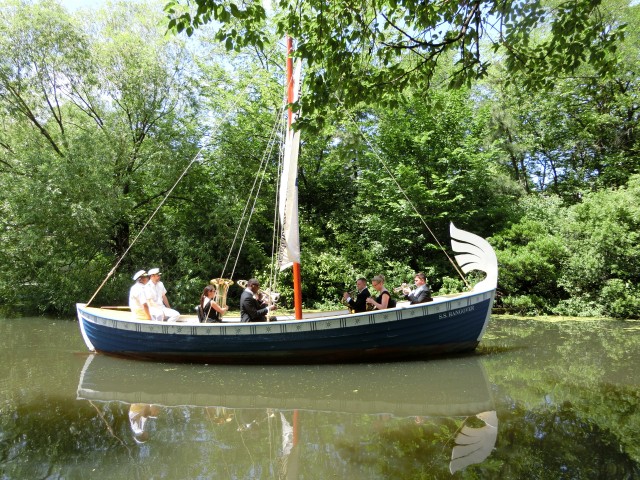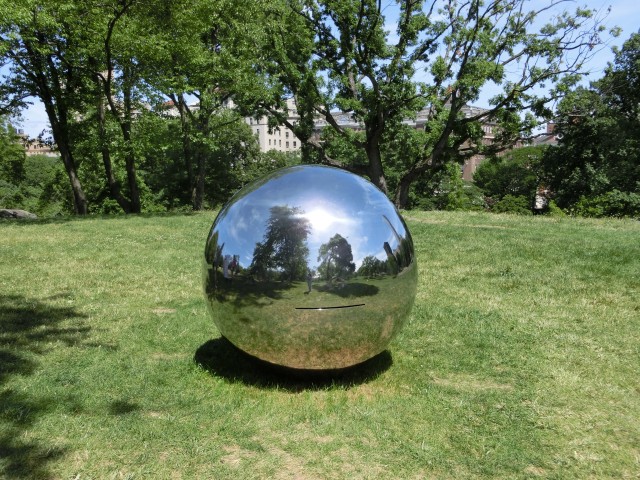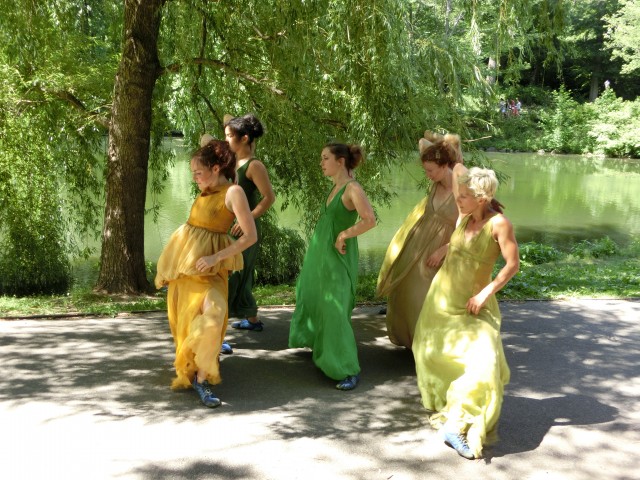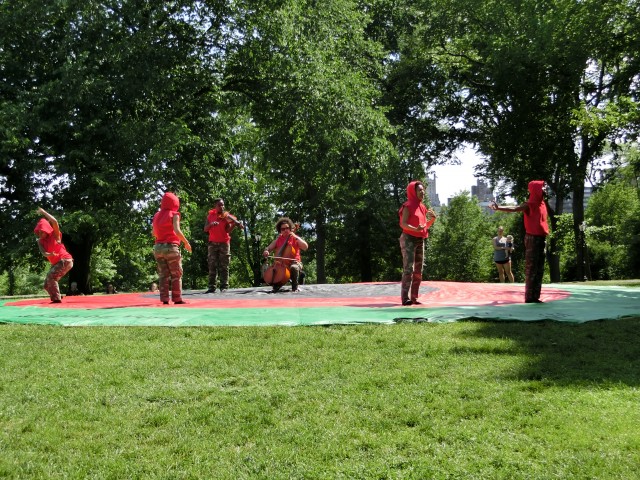
Ragnar Kjartansson’s “S.S. Hangover” sails around Harlem Meer with members of the Metropolis Ensemble (photo by twi-ny/mdr)
Central Park
Begin at Charles A. Dana Discovery Center
Enter at 110th St. & Fifth Ave.
Friday, June 19, and Saturday, June 20, free, 12 noon – 6:00 pm
creativetime.org
www.centralparknyc.org
drifting in daylight slideshow
While making my way through the wonderful “Drifting in Daylight” exhibition in Central Park, comprising eight site-specific projects commissioned by the nonprofit arts organization Creative Time and the Central Park Conservancy, I heard some beautiful music coming out of the North Woods. Believing I had found number 5B on the map, which promised “a migratory performance of contemplative movement through the North Woods,” I wandered down a path until I came upon a man and a woman playing Bach on violins. There were a few other people there, so I walked over and started taking some photos and enjoying the performance. “Excuse me,” a young man said to me as the music continued, “this is a private gathering.” Not sure whether he was being serious or that was part of the installation — you can’t always tell with contemporary art, of course — I told him that this was where the map indicated the next stop was. “It’s over there,” he said with a determined annoyance, pointing to the nearby overpass. So off I went, shortly to discover a group of dancers moving silently on the asphalt road and the grass. This time, I was where I was supposed to be, watching Lauri Stallings + Glo’s “And All Directions, I Come to You,” but as I followed them through the trees by the Pool, there were two people rehearsing Shakespeare, members of New York Classical Theatre’s free outdoor production of The Taming of the Shrew. And then two other actors passed by, a man and a woman, re-creating a scene from Wes Anderson’s The Royal Tenenbaums in which former spouses Royal (Gene Hackman) and Etheline Tenenbaum (Anjelica Huston) discuss how they raised their crazy kids; it is part of David Levine’s “Private Moments,” one of eight such scenes occurring throughout the park, where they were originally filmed. I suddenly didn’t know where to turn, what to see next, surrounded by a surfeit of art, yet wondering what was public and what was private. “Nothing can be written on the subject in which extreme care is not taken to discriminate between what is meant in common use of the words garden, gardening, gardener, and the art which I try to pursue,” Central Park architect Frederick Law Olmsted wrote, and indeed, there is plenty of art to pursue among the gardens in Central Park, whether part of “Drifting in Daylight” or not.

Alicia Framis’s “Cartas al Cielo” gives visitors a chance to send a message to someone not of this earth any longer (photo by twi-ny/mdr)
The centerpiece of the Central Park Conservancy’s thirty-fifth anniversary celebration, “Drifting in Daylight,” a kind of art scavenger hunt, begins behind the Charles A. Dana Discovery Center, where Ragnar Kjartansson’s “S.S. Hangover” starts its musical journey around Harlem Meer, its Pegasus flag swirling in the wind, with a brass sextet from the Metropolitan Ensemble on board, playing a dirgelike composition by Kjartan Sveinsson. The 1934 wooden fishing boat has been refashioned into a boat from James Whale’s 1935 film, Remember Last Night?, which was based on the Adam Hobhouse novel The Hangover Murders about a group of characters too drunk to recall a killing. The winding path next leads to Karyn Olivier’s “Here and Now/Glacier, Shard, Rock,” a triptych lenticular billboard that evokes the history of Central Park by shifting between shots of a glacier, a broken piece of pottery from Seneca Village, and rocks, bringing them all together as they appear and disappear. As you approach Conservatory Garden, which is now in beautiful full bloom, you can stop at Spencer Finch’s “Sunset (Central Park),” a solar-powered painted ice-cream truck that offers free soft-serve ice cream that changes colors matching the setting sun. Finch, who also currently has hue-based artworks at the Morgan Library and on the High Line, calls is an “edible monochrome.” But more important, it’s rather soothing on a hot summer’s day.

Lauri Stallings + Glo’s “And All Directions, I Come to You” gracefully and dramatically moves through the north end of Central Park (photo by twi-ny/mdr)
On the south side of Conservatory Garden, Alicia Framis’s “Cartas al Cielo” sits atop a hill, a large, reflective silver orb that glitters in the sunlight. Meaning “letters to the sky,” the participatory sculpture, which is like a doorway to a more ethereal kind of Central Park, invites people to fill out a postcard to someone not on this earth and slip it into one of the globe’s mail slots. You can send a missive to a lost loved one or even an alien, as it boasts otherworldly qualities. Heading toward the Ravine, you’ll soon see nine women — Anicka Zaneta Austin, Kristina Marie Brown, Jennifer Cara Clark, Mary Virginia Coleman, Ashley I Daye, Christina Kelly, Mary Jane Pennington, Cailan Orn, and Katherine Maxwell — performing Atlanta-based choreographer Stallings “And All Directions, I Come to You,” in which the dancers, wearing long dresses of different solid colors forming a unique rainbow, fall on the grass, sit on the path, weave around trees, and invite the audience to join a group circle. Also taking place by the North Woods and the Loch, it’s fast-paced and unpredictable, especially to people who are in the area but have no idea what’s going on, just spending an afternoon in the park. Meanwhile, along North End Drive, three of Nina Katchadourian’s handwoven bird nests, collectively known as “The Lamppost Weavers,” hang from streetlamps, including one consisting of repurposed sneakers that evoke the runners passing by but don’t offer the birds much of a place to set up house. The lampposts are not exactly easy to find; nor are all eight of Levine’s “Private Moments,” which are scattered throughout the park and also feature actors re-creating scenes from Bullets Over Broadway, Symbiopsychotaxiplasm, Six Degrees of Separation, Portrait of Jennie, The Out-of-Towners, Cruel Intentions, and Marathon Man, in which one brave soul spends all afternoon jogging around the Reservoir.

Marc Bamuthi Joseph’s “Black Joy in the Hour of Chaos” provides a powerful conclusion to park project (photo by twi-ny/mdr)
The eighth and final project, Marc Bamuthi Joseph’s “Black Joy in the Hour of Chaos,” is the most powerful. On the Great Hill, taking place on a parachute in colors evoking the flags of Africa and with multiple translations of the phrase “black joy” running around its perimeter, five actors, a violinist, and a cellist, all wearing fatigue pants and red hoodies, mix dance, music, theater, and spoken word as they provide a full-frontal assault on the race war dominating the country, asserting their individual and group identity as they invoke such names as Michael Stewart, Sean Bell, and Freddie Gray. At the end of the riveting performance, people are asked to help lift the parachute, but once it’s raised, it’s dropped again, not remaining up, as we still has quite a way to go before inviting everyone inside the big tent. It’s a compelling experience, and one that puts a provocative cap on a thoroughly engaging exhibition that highlights the diverse nature of Central Park and of New York City and recalls what the Olmsted brothers wrote in 1903 in a report on parks in Portland, Oregon: “All agree that parks not only add to the beauty of a city and to the pleasure of living in it, but are exceedingly important factors in developing the healthfulness, morality, intelligence, and business prosperity of its residents. Indeed it is not too much to say that a liberal provision of parks in a city is one of the surest manifestations of the intelligence, degree of civilization, and progressiveness of its citizens.”